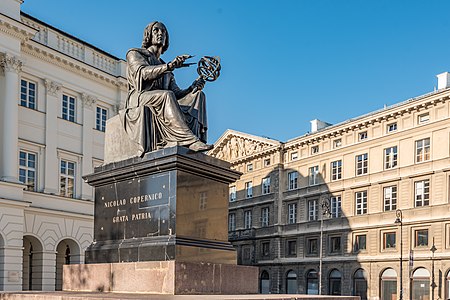Nicolaus Copernicus Monument, Warsaw
1822 sculptures1830 in Poland1830 sculpturesBronze sculptures in PolandBuildings and structures in Warsaw ... and 8 more
Cultural depictions of Nicolaus CopernicusMonuments and memorials in WarsawMonuments and memorials to scientistsOutdoor sculptures in PolandPlaster sculptures in DenmarkSculptures by Bertel ThorvaldsenSculptures of the Thorvaldsen MuseumVandalized works of art

The Nicolaus Copernicus Monument in Warsaw is one of the Polish capital's notable landmarks. It stands before the Staszic Palace, the seat of the Polish Academy of Sciences on Krakowskie Przedmieście. Designed by Bertel Thorvaldsen in 1822, it was completed in 1830. Thorvaldsen's original plaster model from 1822 and a smaller study from 1821 are both held by the Thorvaldsen Museum in Copenhagen.
Excerpt from the Wikipedia article Nicolaus Copernicus Monument, Warsaw (License: CC BY-SA 3.0, Authors, Images).Nicolaus Copernicus Monument, Warsaw
Warsaw Śródmieście (Warsaw)
Geographical coordinates (GPS) Address Nearby Places Show on map
Geographical coordinates (GPS)
| Latitude | Longitude |
|---|---|
| N 52.23816 ° | E 21.01797 ° |
Address
Warsaw, Śródmieście (Warsaw)
Masovian Voivodeship, Poland
Open on Google Maps









